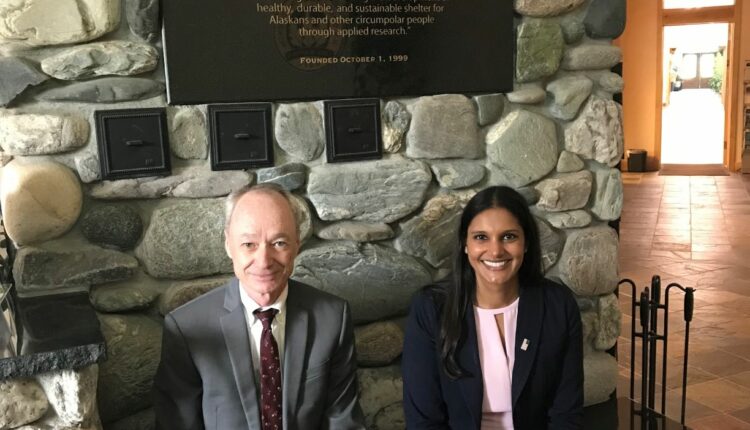
Site Visit: Advocacy Visits Cold Climate Housing Research Center in Fairbanks, Alaska
By Prianka Sharma, Assistant Chief Counsel
While in Fairbanks, Alaska, Advocacy staff visited the Cold Climate Housing Research Center. This nonprofit research and testing facility was founded in 2006 to find energy efficient building technologies for people living in polar environments.
The center was developed by members of the Alaska State Home Builders Association, 90 percent of the association members are general contractors from across the state of Alaska. The center’s building is the northernmost LEED-certified green building in the world, and Advocacy staff were fortunate that it had air purification filters to provide a respite from wildfire smoke in the area.
Alaska has many unique environmental challenges that most commercial and large building companies in the lower 48 states are ill-equipped to handle. The center works to find innovative, cost-efficient, and energy efficient solutions to help address issues in this harsh climate.
For instance, in some parts of the state, the ground never dries out completely. According to center staff, homes built by the U.S. Department of Housing and Urban Development following a natural disaster failed to account for this and other complexities. The staff stated that this is often the case when government agencies provide aide and relief—they do not take into account the physical environment in Alaska.
Alaska is home to three mountain ranges that contain 17 of the 20 tallest peaks in the United States. The temperature swings from minus 80 degrees Fahrenheit in the winter to 100 degrees Fahrenheit in the summer. Builders have to use materials that are adaptable to both extremes.
Another environmental challenge is the state’s frequent seismic activity, as evidenced by the 7.1 magnitude earthquake that hit south central Alaska in 2018. Since then the center has been working to develop earthquake-resistant homes.
One example of an innovative solution to an Alaska-specific problem is placing insulation on the outside of homes; this places the condensation point outside the structure and keeps it from rotting. The center is also working on a program of homes modeled on the “Ikea” system—flat packaged units that can be assembled without expert assistance. Shipping is a major issue in the state because many cities, including the capital city of Juneau, are only accessible by plane or boat. Shipping costs are so exorbitant that large parts and prefabricated homes cannot be shipped to remote areas. The “Ikea” model would have all of the necessary parts of a home packed in a flat box with instructions; it would be easy and cost-effective to ship, and the end user could ideally assemble it themselves without having to pay an expert to fly or be transported by vessel to their location.
Along with homebuilders across the country, Alaskan businesses also struggle with the Waters of the United States rule and its impact on homebuilding, as well as various other permitting issues including Endangered Species Act. An additional issue they face is the lack of skilled workforce trained to build in the Alaskan climate. Trainings can be expensive and require a large amount of time. The center hopes to streamline trainings so that the Alaskan workforce is educated, skilled and prepared to deal with the many obstacles they may encounter in homebuilding.
One of the many themes that emerged from Advocacy’s trip to Alaska was that what works for the lower 48, does not work for Alaska. Federal regulators need to be more cognizant of this reality in writing and implementing rules.
Advocacy was in Alaska for Regional Regulatory Reform Roundtables July 9-11.
Can’t get to a roundtable near you? Fill out this form and tell us about your federal
regulatory burdens. We will pass this information on to the appropriate agency
and use it in the planning of upcoming Regional Regulatory Reform Roundtables.
For more information on Advocacy’s mission, our regulatory reform efforts or to find out where the next Regional Regulatory Reform Roundtables will be held, please visit: https://advocacy.sba.gov/regulation/regulatory-reform/.
Prianka Sharma is an Assistant Chief Counsel for Advocacy whose portfolio includes agriculture, energy, and natural resources. Sharma can be reached at Prianka.sharma@sba.gov.
